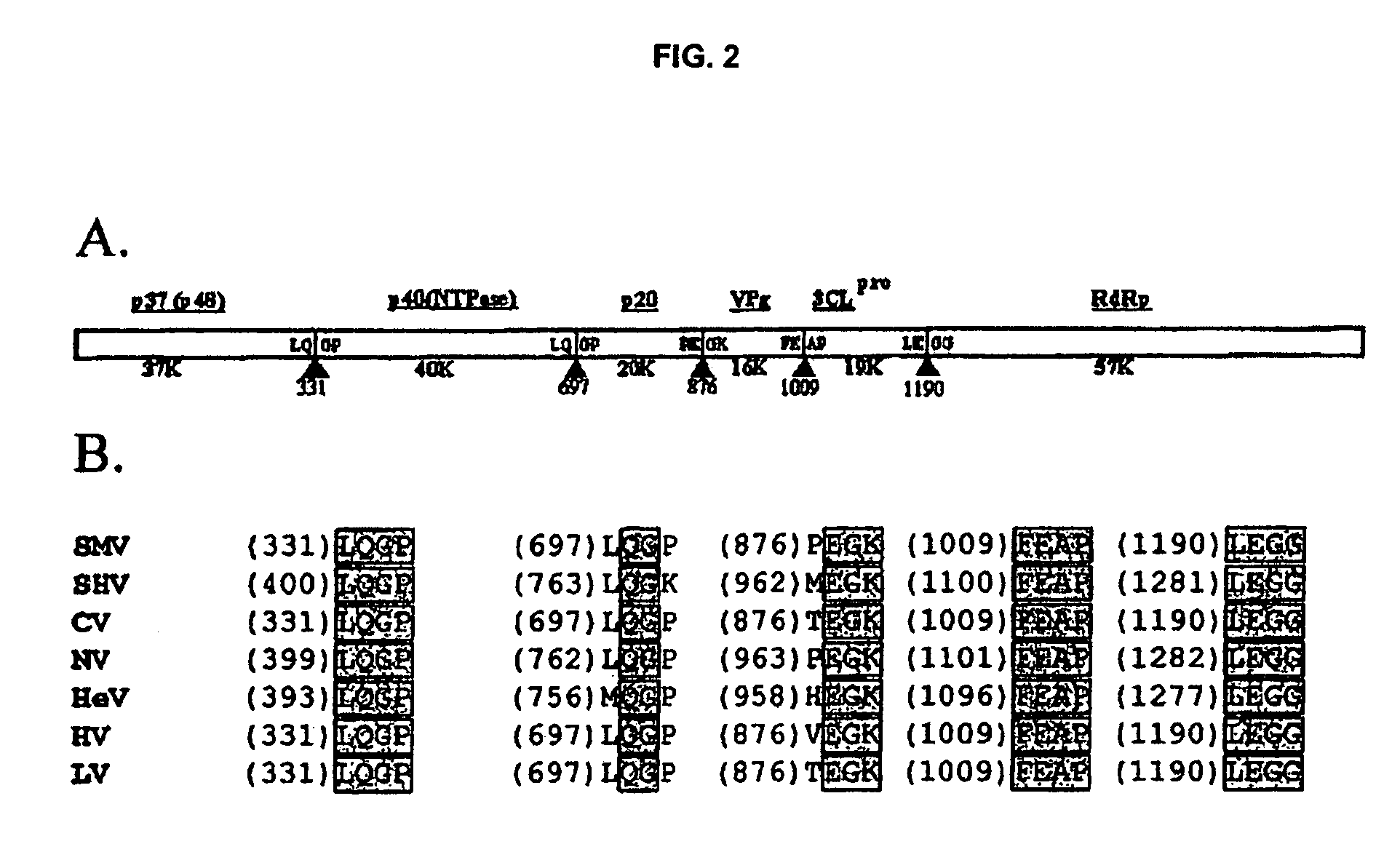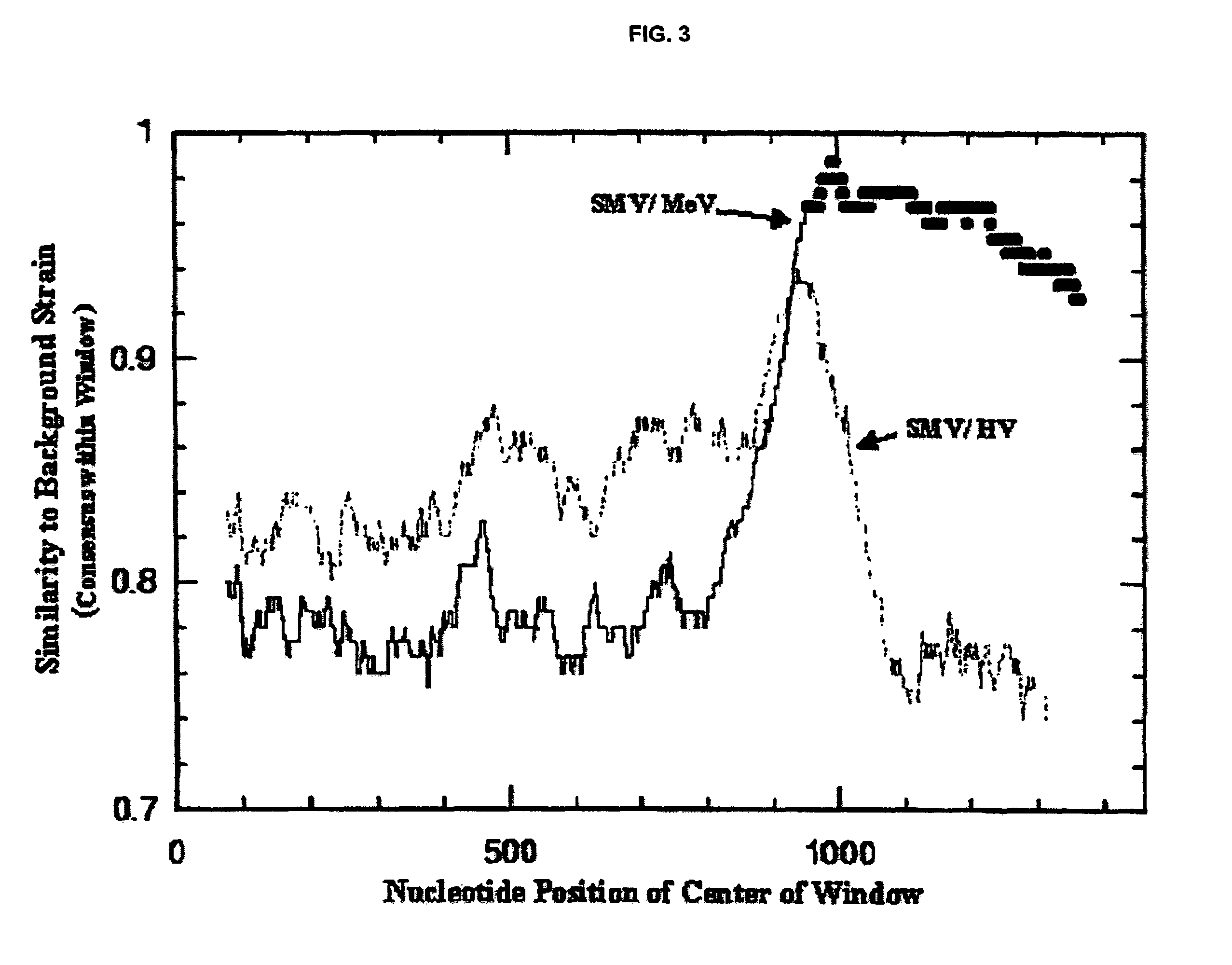Snow mountain virus genome sequence, virus-like particles and methods of use
a technology of virus genome and viruslike particles, which is applied in the field of snow mountain virus genome sequence, viruslike particles and methods of use, can solve the problems of large outbreaks that often persist, 55% of guests reporting illness, and difficult classification of smv and other hucv
- Summary
- Abstract
- Description
- Claims
- Application Information
AI Technical Summary
Benefits of technology
Problems solved by technology
Method used
Image
Examples
example 1
Viral RNA Extraction
[0118]A stool sample from a SMV-infected volunteer diluted in phosphate-buffered saline (PBS) was extracted essentially as described with modifications. (Wang et al. J Virol. 1994 September; 68(9):5982-90.) One hundred microliters of a 20% suspension in PBS was extracted with Vertrel XF (Dupont) and virus particles per precipitated with 8% PEG (MW 8000) and 0.4 M NaCl. (Mendez et al. J Virol Methods. 2000 October; 90(1):59-67.) Precipitated virus particles were digested with 400 μg / ml proteinase K, and virus RNA (vRNA) then was precipitated with cetyltrimethylammonium bromide (CTAB) in the presence of 2 M NaCl. Further purification and concentration of the vRNA was achieved by phenol / chloroform extraction, followed by chloroform extraction, and finally precipitation with 0.2 M sodium acetate and 2.5 volumes of ethanol. The vRNA pellet was suspended in ribonuclease free water for injection (WFI) and stored at −20° C.
example 2
Cloning and Sequencing
[0119]SMV cDNA was amplified by RT-PCR from the purified vRNA template with AMV-RT (Promega, Madison, Wis.) and specifically designed oligonucleotide primers (Integrated DNA Technologies, Coralville, Iowa). cDNAs covering the complete genome of SMV were obtained in a total of six PCR fragments with the primers listed in Table 1. The locations of the primers on the genome are indicated in FIG. 1. Primers used to amplify SMV ORF1 were designed from conserved regions of three aligned calicivirus sequences: NV (Genbank Acc. No. M87661), LV (X86557), and CV (AF145896). SMV OFR2 primers were designed from SMV capsid sequence (U75682), and ORF3 primers were designed from the closely related (94% nt identity) MeV ORF3 sequence (X81879). The 3′ end of SMV was amplified with an oligo dT primer and primer SMV7 (SEQ ID NO:11). Viral template (0.5 μl) and 2.5 μM of each downstream primer were combined and incubated for 5 minutes at 70° C. then cooled on ice. An RT reaction ...
example 3
Sequence Analyses
[0123]Sequence identities were determined by separately aligning OFR1, ORF2, and ORF3 sequences of NV, SHV (L07418), HeV (AF093797), Hv (U07611), CV, LV, MeV ORFs 2 and 3 (X81879), and SMV. The sequences were aligned with the AlignX program in the Vector NTI v5.0 program and compiled as pairwise identities. AlignX employs the Clustal W alignment algorithm. (Thompson et al. Nucleic Acids Res. 1994 Nov. 11; 22(22):4673-80.)
[0124]The Recombination Identification Program (RIP) was used to evaluate SMV as a potential recombinant virus. (Siepel et al. AIDS Res Hum Retroviruses. 1995 November; 11(11): 1413-6) RIP employs a window that moves across a determined number of nucleotides in an alignment. At each position of the window, the query sequence is compared to a specified number of background sequences. This nucleotide block is then quantified as the percentage of identical base pairs, and the window advances to the next position. The output display reveals the identiti...
PUM
| Property | Measurement | Unit |
|---|---|---|
| Fraction | aaaaa | aaaaa |
| Fraction | aaaaa | aaaaa |
| Fraction | aaaaa | aaaaa |
Abstract
Description
Claims
Application Information
 Login to View More
Login to View More - R&D
- Intellectual Property
- Life Sciences
- Materials
- Tech Scout
- Unparalleled Data Quality
- Higher Quality Content
- 60% Fewer Hallucinations
Browse by: Latest US Patents, China's latest patents, Technical Efficacy Thesaurus, Application Domain, Technology Topic, Popular Technical Reports.
© 2025 PatSnap. All rights reserved.Legal|Privacy policy|Modern Slavery Act Transparency Statement|Sitemap|About US| Contact US: help@patsnap.com



